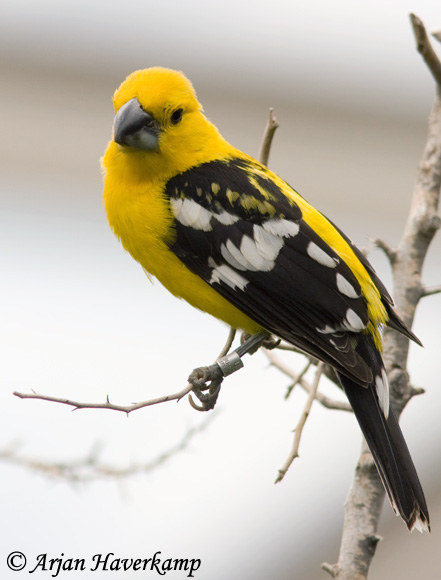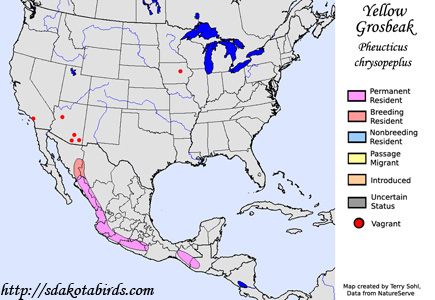| Length: 9 inches | Wingspan: 14.5 inches | Seasonality: Non-resident in South Dakota |
| ID Keys: Bright yellow overall, black wings with white spots, black tail | ||
 The
Yellow Grosbeak is related to the Rose-breasted Grosbeak and Black-headed
Grosbeak found in the United States. However, it is found in western
Mexico and Guatemala, and is only a very rare stray to the United States,
where individual birds have been sighted in southern Arizona a number of
times. In the U.S. it has only been seen a scant handful of times
outside of Arizona. They are occasionally kept as captive birds, so
occasional (but extremely rare) sightings away from Arizona may represent
escaped captives.
The
Yellow Grosbeak is related to the Rose-breasted Grosbeak and Black-headed
Grosbeak found in the United States. However, it is found in western
Mexico and Guatemala, and is only a very rare stray to the United States,
where individual birds have been sighted in southern Arizona a number of
times. In the U.S. it has only been seen a scant handful of times
outside of Arizona. They are occasionally kept as captive birds, so
occasional (but extremely rare) sightings away from Arizona may represent
escaped captives.
Habitat: Found in semi-open habitat with brush and thickets, typically a semi-open woodland or scrubland.
Diet: Feeds on seeds, fruits, and berries, as well as insects and spiders.
Nesting: The nest of a Yellow Grosbeak is built in a bush or in a small tree, and consists of a small cup built of twigs, leaves, grasses, and leaves. Both parents help to incubate the eggs, and both parents tend to the young upon hatching.
Song: Song of the Yellow Grosbeak is a series of sweet, slow whistles.
Migration: Considered a permanent resident throughout most of their range. However, there is a slight range expansion to the north during the summer breeding season.
Interactive eBird map: Click here to access an interactive eBird map of Yellow Grosbeak sightings
Similar Species: Similar in structure to other grosbeak species, but brilliant yellow plumage makes them a bird unlikely to be confused with another species.
Conservation Status: Overall population trends appear to be decreasing in their native range, but they are still relatively common and widespread. The IUCN lists the Yellow Grosbeak as a species of "Least Concern".
Further Information: 1) Cornell's Neotropical Birds - Yellow Grosbeak
2) Wikipedia - Yellow Grosbeak
3) Internet Bird Collection (IBC) - Yellow Grosbeak
Photo Information: Photo taken by Arjan Haverkamp - Licensed under Creative Commons Attribution 2.0 Generic License
| Click below for a higher-resolution map |
 |
| South Dakota Status: Non-resident in South Dakota |
Additional Yellow Grosbeak Photos (coming soon!!)
